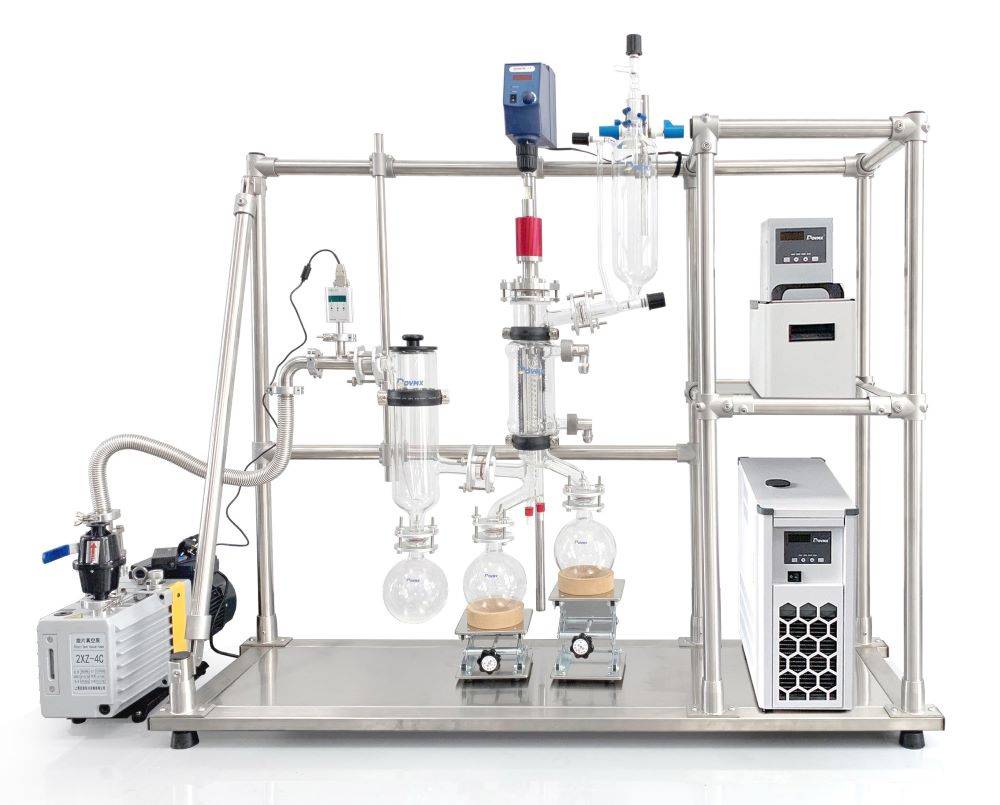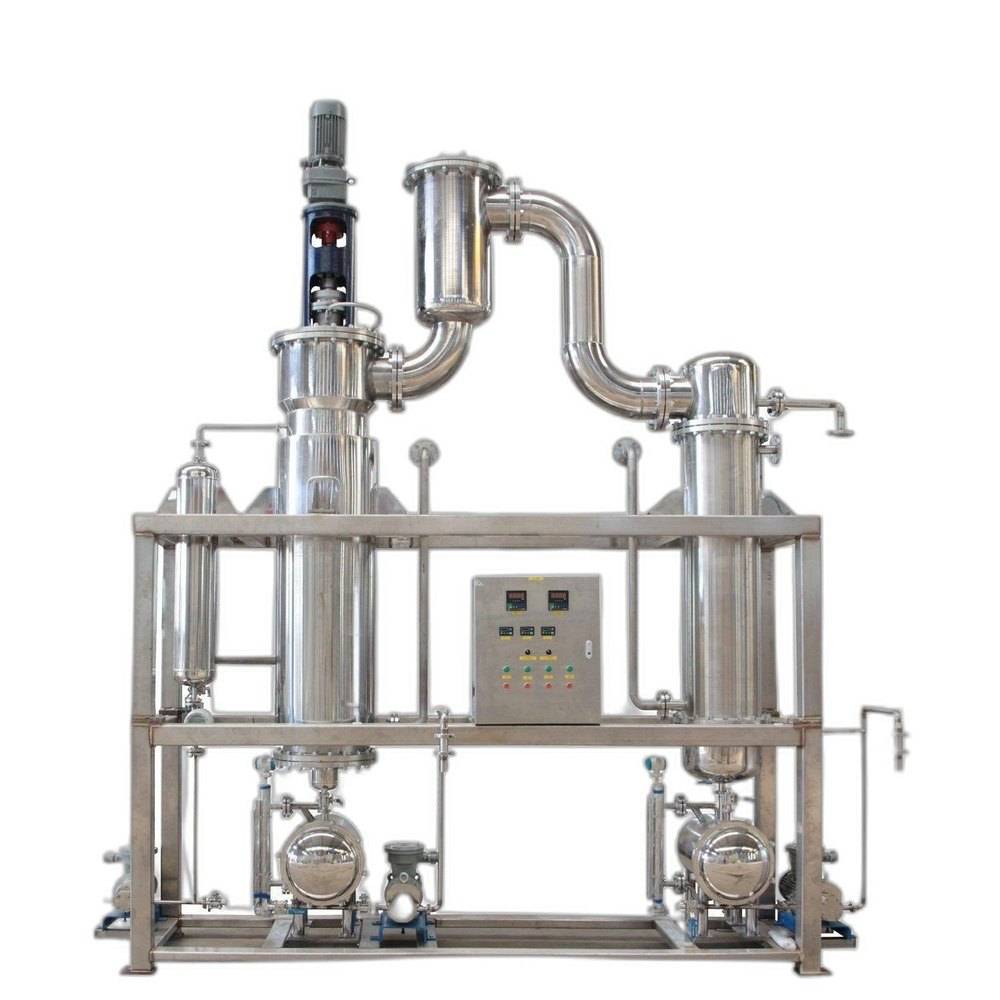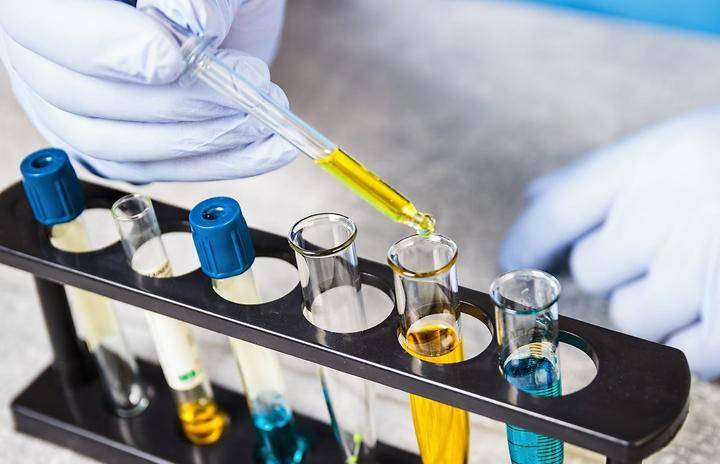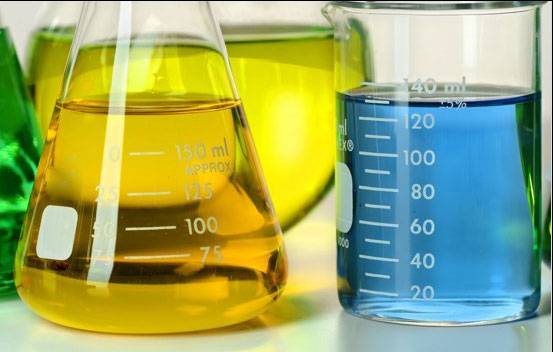Working Principles
Molecular Distillation Apparatus
Molecular distillation is a specialized liquid-liquid separation technology that operates under vacuum conditions. This process involves spreading the material across scrapers, which significantly accelerates the evaporation of lighter components. The evaporated gases subsequently condense and are efficiently recovered. The apparatus typically consists of several key components, including a vacuum pump, external condenser, and a heating column with a jacketed feeding vessel. These elements work in tandem to maintain a low-pressure environment, crucial for the distillation process.
One of the standout features of molecular distillation is its low-temperature operation, which helps avoid thermal decomposition. The high vacuum applied, often at pressures as low as 10^-3 Torr, ensures that the material is not exposed to atmospheric air, thereby preventing oxidation. This low-pressure environment also facilitates a very short residence time, typically less than a fraction of a second, as the material expands on a pre-heated spinning disc. The distillate, once condensed, flows into the collecting vessel due to gravity, while the residual matter is collected in gutters around the spinning disc and then transferred to a separate collecting vessel below.

The molecular distillation process is particularly advantageous in industries such as food processing, pharmaceuticals, petroleum, and chemicals, where high purity and avoidance of thermal degradation are paramount. The centrifugal force generated by the spinning disc enhances the separation efficiency, making it a preferred method for high-boiling point mixtures and high-purity chemical separations.
Thin Film Evaporator
A thin film evaporator operates as a specialized liquid-liquid separation technology within a vacuum environment. This device employs the use of scrapers to spread the material into a thin film, thereby accelerating the evaporation process of the lighter components. The evaporated gases are then condensed and recovered under the controlled conditions of vacuum pressure.
One of the key advantages of thin film evaporators is their ability to handle temperature-sensitive materials. Many organic substances, such as vitamins, flavoring agents, and pharmaceutical intermediates, are prone to degradation at even moderate temperatures due to factors like thermal decomposition, polymerization, and side reactions. These processes can significantly compromise the quality of the final product.
To mitigate these issues, thin film evaporators utilize extreme reductions in operating pressure and employ specialized designs. This approach allows for a considerable decrease in both the evaporation temperature and the duration of thermal stress on the product. Consequently, the quality of the treated material is greatly enhanced, making thin film evaporators an invaluable tool in industries where maintaining product integrity is paramount.
There are different types of thin film evaporators, each with its unique operational characteristics. For instance, the falling film evaporator operates similarly to a vertical shell and tube heat exchanger. In this setup, the process fluid enters from the top and flows downwards in a thin film along the tube walls, where it is instantly converted into vapor by the hot utility flowing in the shell. This type of evaporator is custom-designed to meet specific process requirements.
On the other hand, the wiped film evaporator functions on the principle of thermal separation, generating a thin, highly turbulent liquid film along the outer surface of the evaporator. This method is particularly effective for materials that require gentle handling to prevent degradation.

In summary, thin film evaporators are essential in processes where the preservation of product quality is critical, offering a balance between efficient separation and minimal thermal impact.
Scope of Application
Molecular Distillation Apparatus
Molecular distillation apparatus is specifically designed for the separation of components within high boiling point mixtures, making it an indispensable tool in industries requiring high-purity chemicals, petrochemicals, and pharmaceuticals. This technology operates under a vacuum state, where the pressure is maintained at a very low level, typically around 10^-3 Torr, to facilitate the distillation process at extremely low temperatures. This ensures that thermal decomposition is minimized, preserving the integrity and purity of the substances being processed.
The apparatus consists of several key components that work in concert to achieve efficient separation:
- Vacuum Pump: Maintains the low-pressure environment necessary for molecular distillation.
- External Condenser: Condenses the evaporated gases, facilitating their collection.
- Magnetic Stirrer: Ensures uniform distribution of the mixture within the apparatus.
- Glass Barrel with Jacketed Internal Condenser: Provides controlled cooling and heating, crucial for maintaining the desired temperature gradient.
- Heating Column with Jacketed Feeding Vessel: Preheats the feed material, enhancing the distillation process.
- Cooling Coils for Cold Molecule Trapping: Ensures efficient trapping of cold molecules, aiding in the separation process.
- Continuous Collection Unit for Distillate and Residue: Collects both the purified distillate and residual matter, ensuring a complete separation process.
- Gear Pump for Constant and Automatic Feeding: Maintains a steady flow of the feed material, optimizing the distillation efficiency.
The molecular distillation process begins with the degassing of the feed material, which is then introduced into a pre-heated spinning disc. The material expands rapidly upon contact with the heated disc, completing the distillation process in a fraction of a second. The distillate, now condensed on the outer extremes of the shell, flows into the collecting vessel due to gravity. The residual matter is collected in a gutter around the spinning disc and is subsequently transferred to a separate collecting vessel below.
This method of purification, widely utilized in food processing, pharmaceutical applications, petroleum industries, and chemical industries, leverages the principles of low pressure and very short residence time to achieve unparalleled separation efficiency and purity.

Thin Film Evaporator
Thin film evaporators are highly effective for the separation of components in mixtures with low boiling points, making them indispensable in industries such as food, cosmetics, and environmental protection. These evaporators operate by spreading the material to be treated in a thin film across the walls of tubes or the outer surface of the evaporator, which is then rapidly heated. The rapid heating process converts the material into vapor, which is subsequently condensed and recovered.
One of the standout features of thin film evaporators is their ability to handle temperature-sensitive materials. Many organic substances, such as vitamins, flavoring agents, and pharmaceutical intermediates, can degrade at even low temperatures due to thermal decomposition, polymerization, and side reactions. Thin film evaporators mitigate this issue by significantly reducing the operating pressure and optimizing the design, thereby lowering the evaporation temperature and the duration of thermal stress. This results in a substantial improvement in the quality of the final product.
There are two primary types of thin film evaporators: the falling film evaporator and the wiped film evaporator. The falling film evaporator operates similarly to a vertical shell and tube heat exchanger, where the process fluid enters from the top and flows in a thin film along the tube walls, instantly converting into vapor upon contact with the hot utility in the shell. On the other hand, the wiped film evaporator functions like a thin film evaporator but with a mechanically generated, thin, and highly turbulent liquid film along the outer surface of the evaporator, enhancing the efficiency of the thermal separation process.
In summary, thin film evaporators are versatile tools for industries requiring the separation of low-boiling point mixtures while maintaining the integrity of temperature-sensitive materials. Their ability to reduce thermal stress and improve product quality makes them a preferred choice in various applications.
Energy Consumption and Cost

Molecular Distillation Apparatus
Molecular distillation apparatus demands sophisticated high vacuum systems and high-precision temperature control mechanisms, which significantly escalate its operational costs. These systems are indispensable for maintaining the ultra-low pressures required for molecular distillation, typically operating at pressures as low as 10^-3 Torr. The high vacuum not only facilitates the rapid evaporation of light components but also prevents oxidation by eliminating exposure to atmospheric air.
Moreover, the intricate temperature control ensures that the distillation process occurs at very low temperatures, averting thermal decomposition of the sensitive materials being processed. This precision control is crucial for maintaining the integrity and purity of the distillate, which is paramount in industries such as pharmaceuticals and high-purity chemical production.
The equipment itself comprises a complex array of components, including a glass barrel with a jacketed internal condenser, a heating column with a jacketed feeding vessel, and a continuous collection unit for distillate and residue. Each of these components plays a vital role in the efficient operation of the molecular distillation process. For instance, the external condenser and cooling coils are essential for trapping cold molecules and ensuring the rapid condensation of the distillate, thereby enhancing the overall efficiency of the distillation.
In summary, while the high costs associated with molecular distillation apparatus are substantial, they are justified by the superior separation efficiency and purity it delivers, making it an indispensable tool in high-precision industrial applications.
Thin Film Evaporator
Thin film evaporators are renowned for their efficiency in energy consumption and compact equipment size, which translates to significantly lower operational costs compared to other distillation methods. This efficiency is largely due to the unique design and operation principles of thin film evaporators, which allow for the rapid evaporation of materials under reduced pressure.
In a thin film evaporator, the process fluid enters from the top and flows in a thin layer along the walls of the tubes. This thin film formation is crucial as it maximizes the surface area exposed to the heating medium, thereby accelerating the evaporation process. The rapid conversion of the liquid into vapor minimizes the duration of thermal stress on the product, which is particularly beneficial for heat-sensitive materials such as vitamins, flavoring agents, and pharmaceutical intermediates.
Moreover, the reduced operating pressure in thin film evaporators significantly lowers the evaporation temperature. This reduction in temperature not only enhances the quality of the final product by preventing thermal decomposition, polymerization, and side reactions but also contributes to the overall energy efficiency of the system. The combination of these factors results in a highly cost-effective solution for thermal separation processes, making thin film evaporators an ideal choice for industries requiring efficient and gentle separation of low-boiling point mixtures.
Separation Efficiency and Purity

Molecular Distillation Apparatus
Molecular distillation apparatus is renowned for its exceptional separation efficiency and purity, often surpassing 99.9%. This high performance is achieved through a combination of low pressure and extremely short residence times, which prevent thermal decomposition and oxidation. The process begins with the degassing of the feed material, which is then introduced into a pre-heated spinning disc. The material rapidly expands upon contact with the disc, completing the distillation process in less than a fraction of a second.
The distillate, which condenses on the outer extremes of the shell, flows into the collecting vessel due to gravity. Meanwhile, the residual matter is collected in a gutter around the spinning disc and subsequently transferred to the collecting vessel below. This meticulous process occurs at very low temperatures, ensuring that thermal degradation is avoided. Additionally, the high vacuum applied during the process effectively eliminates oxidation by minimizing exposure to atmospheric air.
| Feature | Description |
|---|---|
| Vacuum Pressure | Operates at a pressure of 10^-3 Torr, significantly lower than free path distillation (10^-2 Torr). |
| Residence Time | Extremely short, typically less than a fraction of a second. |
| Temperature Control | Maintains low temperatures to prevent thermal decomposition. |
| Oxidation Prevention | High vacuum minimizes exposure to atmospheric air, preventing oxidation. |
The molecular distillation apparatus is a sophisticated technology that finds widespread application in industries such as food processing, pharmaceuticals, petroleum, and chemicals. Its ability to deliver ultra-high purity and efficiency makes it indispensable for high-precision separation needs.
Thin Film Evaporator
The thin film evaporator operates under vacuum conditions, facilitating the rapid evaporation of light components by spreading the material across scrapers. This method, however, tends to yield lower separation efficiency and purity, typically achieving around 90%. This limitation is particularly evident in applications involving delicate organic substances, such as vitamins, flavoring agents, and pharmaceutical intermediates, which are susceptible to thermal degradation at even moderate temperatures.
Due to the inherent nature of thin film evaporation, the process can lead to significant quality losses as the temperature and duration of thermal stress increase. This is where the design and operational parameters of the evaporator play a crucial role. By strategically reducing the operating pressure and optimizing the evaporator's design, it is possible to substantially lower the evaporation temperature and minimize thermal stress on the product. This approach not only enhances the overall quality of the final product but also extends the range of applications for which the thin film evaporator is suitable.
For instance, falling film evaporators and wiped film evaporators are two distinct types of thin film evaporators that employ different mechanisms to achieve similar outcomes. The falling film evaporator operates by allowing the process fluid to flow in a thin film along the walls of tubes, where it is instantly converted into vapor by the heat from the utility flowing in the shell. On the other hand, wiped film evaporators create a mechanically generated, thin, and highly turbulent liquid film along the outer surface of the evaporator, enhancing the rate of evaporation.
Despite these advancements, the thin film evaporator remains less efficient in terms of separation purity compared to other distillation methods, such as molecular distillation. However, its lower energy consumption and relatively smaller equipment size make it a cost-effective solution for applications in food, cosmetics, and environmental protection, where high purity is not the primary concern.
Related Products
Related Articles
- How to Choose the Best Rotary Evaporator (Rotavapor) for Your Budget
- Boost Your Efficiency Why A Rotary Evaporator Is Better
- Understanding Evaporation Boats in Vacuum Coating
- Comparing Chemical Vapor Deposition and Physical Vapor Deposition
- A Comparative Study of Evaporation and Sputtering Techniques in Thin Film Deposition

